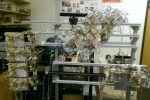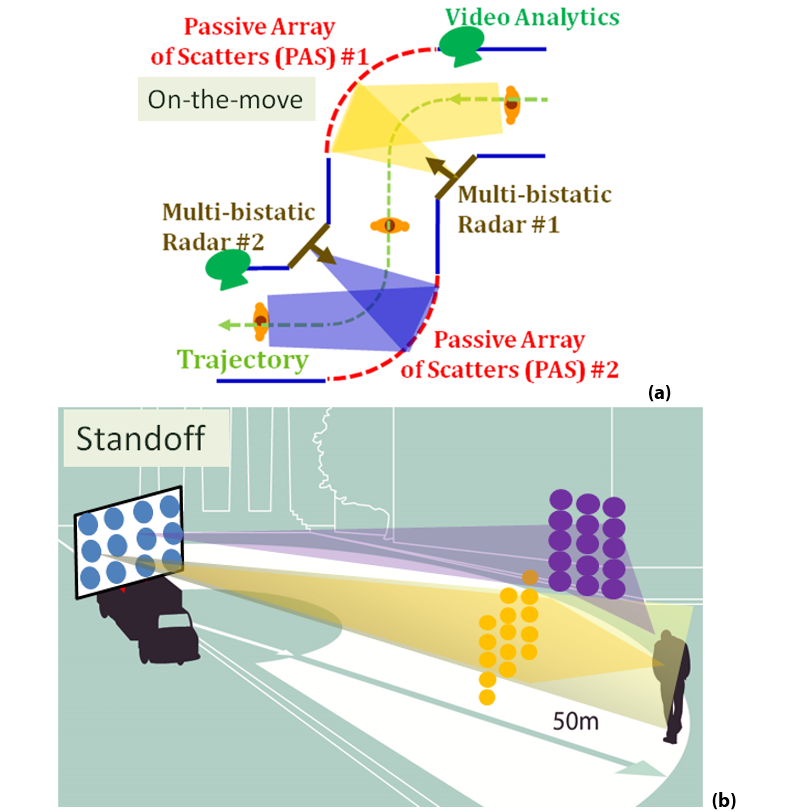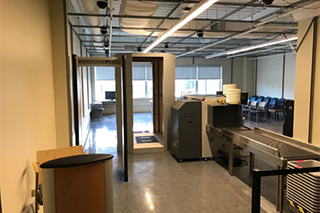News & Events
Industry
ALERT Launches Video Analytics Lab at Kostas Research Institute May 30, 2017

A Better Testing Facility for Solving Real World Problems
Northeastern University’s George J. Kostas Research Institute for Homeland Security is now home to ALERT’s new Video Analytics Laboratory. Providing secure access, 1225 sq. feet of open space, controlled lighting conditions, and a fully networked and flexible camera grid, ALERT can better investigate and develop video and sensor technologies to address the needs of the Homeland Security Enterprise.
Using Video Technologies to Improve Passenger Experience
The first research project to leverage the lab is entitled Research and Development of Systems for Tracking Passengers and Divested Items at the Checkpoint. Supported by the DHS Science and Technology Directorate through the DHS Office of University Programs, this project is known by the acronym CLASP (Correlating Luggage and Specific Passengers) and leverages the technical expertise of ALERT research teams from Boston University, Marquette University, Northeastern University, Purdue University, and Rensselaer Polytechnic Institute. These teams will work towards developing an automated system capable of tracking passengers and divested items at airport security checkpoints.
CLASP will primarily focus on using video technologies to assist the Transportation Security Administration (TSA) in effectively identifying security incidents like theft of items, or bags left behind at the checkpoint. By automating and improving the technologies associated with these objectives, ALERT hopes to improve rates of detection and at the same time improve the passenger experience.
CLASP was the result of DHS’s interest in initial work done by ALERT Project Investigator Richard Radke’s lab. A video of their work can be seen below:
(Z. Wu and R.J. Radke, Real-Time Airport Security Checkpoint Surveillance Using a Camera Network. Workshop on Camera Networks and Wide Area Scene Analysis, in conjunction with CVPR 2011, June 2011.).
Government & Industry Partners Make the Difference
In order to deliver the system outlined in CLASP, the researchers working on the project require access to video data displaying real-world checkpoint security situations. Actual airport security video is generally restricted, so ALERT partnered with Massport, the Transportation Security Administration at Boston Logan International Airport, and industrial partners such as Rapiscan Systems to create an accurate representation of an airport security checkpoint in the ALERT Video Analytics Laboratory. This full-scale, mock airport security checkpoint uses the same hardware and design specifications currently used by the TSA at airports such as Logan, and gives ALERT a space to generate usable video data for this project and hopefully to the video analytics research community as a whole.
CLASP is just the beginning of work that can be done in this new laboratory and ALERT is hoping to leverage it for additional homeland security-related projects going forward. If you are interested in partnering with ALERT on future projects, please connect with us via email at [email protected].
Industry Spotlight: Q&A with Dr. Mark Witinski of Pendar Technologies May 30, 2017

ALERT recently caught up with Dr. Mark Witinski, Vice President of Chemical Analysis & Security Group, at Pendar Technologies. Dr. Witinski served as co-founder and President of Eos Photonics prior to the merger which formed Pendar Technologies. At Pendar Technologies, he focuses primarily on applications development, business to business strategic partnerships, and government sales.
1) Can you describe the work Pendar Technologies does and how it contributes to the Homeland Security Enterprise?
Pendar’s work in furthering the Homeland Security Enterprise takes a few forms. The most critical one – the one that is the focus of our first product – is giving security and military personnel the tools to analyze unknown chemicals in the field and without physical contact. This is generally referred to as “Standoff Detection.”
2) Pendar Technologies is one of ALERT’s industrial members. How has collaboration with ALERT been beneficial to Pendar Technologies?
For Pendar, there are two major benefits to our longstanding ALERT membership. One is direct interaction with thought leaders in the Homeland Security space, where we learn first-hand about the contemporary challenges and frontiers in various security settings. The other major benefit has been formal and informal collaborations with other members of the ALERT community that serve to address those challenges. For instance, Pendar has pursued new sensing modalities with other industrial members and has also fostered collaborations with academic research groups from ALERT affiliated universities including: Northeastern University, Purdue University, Tufts University, The University of Rhode Island, and The University of Puerto Rico.
3) Can you describe some of the technology that has been developed or improved upon through the Pendar Technologies/ALERT partnership?
Sure. Pendar uses a unique laser technology called the Quantum Cascade Laser. Critical advancements in that technology were made through two years of partnership with ALERT and The John Adams Institute for Innovation (JAII). This work was especially important as it came during a very formative time in our company. Working with ALERT and JAII helped to reduce the market risk pursuing the technological path that we were on.
4) You completed your doctorate in Chemical Physics at Cornell University where your research focused on molecular beams and laser spectroscopy to examine the dynamics of molecular collisions. What inspired you to pursue this research area?
This is an interesting question—one I even ask myself sometimes. My graduate work, and my postdoc work for that matter, were both focused on gas phase chemistry. Specifically, I sought to examine the detailed aspects of individual molecular reactions to gain the understanding that underpins how, for instance, ground level pollutants form and how they are removed. The atmosphere is a reactor—a very large and hard to control reactor. As a health matter, dangers lie not only in exposure to chemicals that are directly emitted. Rather, substances and their levels are governed by a complex set of coupled reactions, reactions which I wanted to understand as fully as possible before even attempting to comment on a solution. In this process, I became exposed to many laser technologies, including the Quantum Cascade Laser.
5) Can you describe your current role at Pendar Technologies and how your technical background prepared you for this role?
What I try to do is to listen to leaders from the agencies that all of us rely on to enhance our security. Often, these conversations reveal that many agencies, as well as the Defense Departments of the world share similar needs, although they may not communicate directly with one another. If a security capability is both desired and is lacking in multiple user groups, it tells me that a new capability is truly needed for protection of the public and of military forces. I then work with other Pendar scientists and engineers to see if we can offer a solution.
6) What emerging technology or research in the chemical analysis and security domains are you most excited about?
One of the things about chemical analysis that is not immediately obvious is that, at the most fundamental of levels, we basically have the tools that we are going to have for the foreseeable future: Mass Spectrometry, Infrared Spectroscopy, Chromatography, Raman Spectroscopy, X-Ray Imaging, Ion Mobility Spectrometry, and the list goes on.
What advances the capabilities of these methods is how they are practiced and integrated in a way that leverages advances in other disciplines. For instance, modern systems are engaging high speed portable computing, ever improving camera systems, additive manufacturing technology, wireless communications, etc… It is through careful integration and mastery of the entire chemical/instrument/user system that disruptive advances occur. It seems clear that the necessity of end-to-end mastery in this space is causing security developers to collaborate more, and venues like ALERT are key in fostering needed collaborations.
ADSA16: Bringing Transportation Security Stakeholders Together May 30, 2017

The Sixteenth Advanced Development for Security Applications (ADSA16) Workshop was held on May 2-3, 2017 at Northeastern University in Boston with 160 participants in attendance. The theme for the workshop was “Addressing the Requirements for Different Stakeholders in Transportation Security,” which explored the stakeholder perspectives of the Transportation Security Administration (TSA), airlines, vendors, passengers, academia, and national labs.
Some of the topics discussed at ADSA16 were methods and technologies to optimize airport security checkpoints; emerging technologies; explosives trace detection; deep learning; and techniques and strategies for securing soft targets (malls, arenas, outdoor events).
ADSA16 was unique from previous workshops, because it included the involvement of airline representatives from Alaska Airlines and Jet Blue, who discussed the importance of forming partnerships with aviation security stakeholders during an insightful panel discussion.
The ADSA Workshop series has been convened by the DHS Center of Excellence (COE) for Awareness and Localization of Explosives-Related Threats (ALERT) since 2009. Originally named the “Algorithm Development for Security Applications” Workshop series, the name was changed following ADSA10 in 2014 to reflect how the scope of the workshop series has expanded well beyond algorithms. The ADSA Workshop series is intended to address research opportunities that may enable the development of next-generation systems and to facilitate collaboration and innovation between researchers from academia, national labs, and industry.
The next ADSA Workshop (ADSA17) will be held at the same location on October 17-18, 2017 with the theme “Systems Engineering of Aviation Security Systems.” Specific topics that will be addressed include requirement specifications for systems and subsystems; the acquisition and use of metadata; assessment, management, and use of risk; and layered security. ADSA17 is expected to continue to draw interested and engaged communities from the Homeland Security Enterprise.
For more information about the upcoming ADSA17, please visit the ADSA17 information page. To read up on previous ADSA Workshops, check out ALERT’s collection of final reports.
Spring 2017 ASPIRE Announced January 27, 2017

Every year ALERT and Gordon-CenSSIS host the Annual Student Pipeline Industry Roundtable Event (ASPIRE) aimed at building connections between students and ALERT industrial collaborators. The upcoming ASPIRE will be held on Thursday, March 16, 2017 at Northeastern University and will feature presentations by industry members, a poster session by students, and a “speed-dating” session for students and industry members to have one-on-one time to discuss their common goals.
The previous ASPIRE (held in Spring 2016) was attended by students from ALERT’s academic partner institutions, as well as representatives from the following ALERT industrial collaborators: American Science & Engineering, Analog Devices Inc., HXI LLC, Morpho Detection, Passport Systems Inc., Rapiscan Systems, and Raytheon Company; as well as representatives from two government agencies, the Transportation Security Laboratory (TSL) and the Department of Homeland Security (DHS).
ASPIRE continues to give students the opportunity to present their research and career aspirations to industry members looking to recruit for internships and full-time positions. ASPIRE also offers participants a unique format in which to cover a broad range of topics significant to the Homeland Security Enterprise, and provides students and industry members with meaningful and effective networking opportunities.
This event is by invitation only for our ALERT and Gordon-CenSSIS industry members and students. More details and an agenda are forthcoming.
Photo caption: Yongfang Cheng, Northeastern University PhD candidate meeting with Piero Landolfi and Kurt Bistany of Morpho Detection at the 2016 ASPIRE.
Job Opportunity at Analog Devices December 2, 2016
ALERT Industrial Member, Analog Devices is looking to fill an Electrical Design Engineer position.
Electrical Design Engineer (New Graduate) Job Reference Number: 161791
Job Description:
Seeking a highly motivated entry-level Electrical Design Engineer responsible for Digital/Analog Electronics, FPGA and Microprocessor design with emphasis on high-speed data conversion. Work closely with internal team members to design control systems pertaining to Microwave and Millimeter Wave development programs covering a range of commercial, military, and aerospace applications. Create and release engineering documents and provide technical support to sales and customers.
Principal Job responsibilities will include:
- Design of analog/digital circuits utilizing FPGA, Embedded Processors, high-speed data converters and DDR memory.
- Design DC Power conditioning, management, and sequencing circuits.
- FPGA coding utilizing VHDL/Verilog HDL implementing custom control interfaces, DSP algorithms, and memory interfaces. Test-bench generation, simulation, compilation and timing closure.
- Work closely with PCB designers to specify PCB design rules, component placement, and power plane distribution. Perform PCB signal integrity, crosstalk, and timing analysis.
- Analog/Digital circuit simulation.
- Hardware test, debug, and validation.
Qualifications:
- Recent Graduate, BSEE, MSEE preferred.
- Familiarity with FPGA/CPLD programming and design application, Verilog/VHDL
- Knowledge of Embedded processor code development preferred, C/C++
- Experience with Modelsim, DxDesigner, Xilinx ISE/Vivado, or Mentor CAD tools a plus.
- Candidate must have good communication skills.
- S. Citizenship Required.
For positions requiring access to technical data, Analog Devices, Inc. may have to obtain export licensing approval from the U.S. Department of Commerce – Bureau of Industry and Security and/or the U.S. Department of State – Directorate of Defense Trade Controls. As such, applicants for this position – except US Citizens, US Permanent Residents, and protected individuals as defined by 8 U.S.C. 1324b(a)(3) – may have to go through an export licensing review process.
Analog Devices, Inc. is an Equal Opportunity Employer Minorities/Females/Vet/Disability
RAND 2017 Graduate Student Summer Associate Program November 30, 2016
DHS’s new Federally Funded Research and Development Center (FFRDC), the Homeland Security Operations Analysis Center (operated by Rand) sponsors a Graduate Student Summer Associate Program at RAND. All applications are due January 5, 2016.
This program provides a great opportunity for graduate students across the Centers of Excellence to explore a career serving the Homeland Security Enterprise through FFRDC research and analysis. The program is designed for full-time students who have completed at least two years of graduate work leading to a doctorate or professional degree. Further details about the program and eligibility criteria are described on our Graduate Student Summer Associate Program website.
This year’s application instructions are listed on the program website.
Developing a Next Generation Screening System to Keep First Responders Safe, and People in Motion November 1, 2016

ALERT is working on developing the first inexpensive, high resolution millimeter-wave radar (mm-wave) system for the purpose of detecting and identifying potential suicide bombers in motion and at a safe distance. Current millimeter-wave imaging systems for security screening require people to stop and stand in front of the scanning system. The International Air Transport Association (IATA) has identified that being able to detect security threats without interrupting the motion of the person under test will be one of the most valuable features of the next generation personnel screening systems [Checkpoint of the Future Roadmap 2020, now Smart Security].
Professors Carey Rappaport and Jose Martinez are leading a team that wants to make that feature a reality. ALERT’s mm-wave radar system uses multiple radar sensors simultaneously. By coordinating transmitters and receivers from both sides of a walkway, the full picture of a subject moving between them is formed. At present, mm-wave radar is the only modality that can both penetrate and sense beneath clothing as far as 50 meters away.

General sketch of the inexpensive, high-resolution radar system used for detecting security threats (a) at mid-ranges using an “on-the-move” configuration, and (b) at standoff-ranges using a “van-based” configuration.
The high resolution mm-wave radar system has two configurations. The first configuration, “on-the-move,” will be able to distinguish security threats hidden on individuals at mid-ranges (2-10 meters) even when those individuals are in motion. The second “van-based” configuration of the system would be able to make detections at stand-off ranges (10-40 meters). The system is non-invasive, provides minimally-disruptive scanning with quality imaging and a fast data collection time of less than 10ms. ALERT’s system would also be the first radar system that is capable of functioning at multiple ranges for both indoor and outdoor scenarios
One of ALERT’s Industrial Members, HXI Inc., has been collaborating with our research team on this technology. Together, HXI and ALERT have designed, fabricated, integrated, and validated the radar system. ALERT expects that after the assembling the first Gen-3 prototype, the partnership will transition the technology to the millimeter-wave imaging market. Additionally, new low-cost miniaturized modules are being developed by HXI for the next generation mm-wave system.
To learn more about ALERT and the Development of “Stand-off” & “On-the-Move” Detection of Security Threats, contact ALERT at [email protected] or read more on the project’s page.
Caption: (Image Above Right) Gen-2 mm-wave radar system. The transmitting vertical array is shown on the left of the image, while the receiving horizontal array is shown on the right.
ALERT Welcomes Newest Industrial Member, Analog Devices, Inc. November 1, 2016

ALERT is pleased to announce its newest industrial member, Analog Devices, Inc. (ADI). ADI is a leading designer and manufacturer of high-performance analog and microwave integrated circuits and complete integrated solutions. For more than 50 years, ADI has been at the forefront of innovation in the area of sensing and signal processing for commercial as well as Aerospace and Defense applications. Analog Devices has Massachusetts design centers in Wilmington, Chelmsford, and Norwood. ALERT welcomes Analog Devices, Inc. into our community and is looking forward to a long-standing strategic partnership.
Analog Devices’ Aerospace and Defense division joined ALERT’s Industrial Advisory Board (IAB) in the third quarter of 2016. ADI is interested in collaborating with ALERT faculty on millimeter-wave imaging, signal processing, CT imaging, and stand-off trace explosives detection. Mr. Bryan Goldstein, General Manager of ADI’s Aerospace and Defense division, will be presenting an overview of their company at ALERT’s annual IAB Meeting on Monday, November 14, 2016.
The keynote address for this year’s IAB Meeting will be given by George Naccara, Federal Security Director for the Transportation Administration (TSA) under the Department of Homeland Security at Logan International Airport.
ALERT’s annual IAB Meeting, and other members-only events give industrial members the opportunity to network with other members, faculty from ALERT’s partner institutions, and local, state, and federal representatives. Other advantages of ALERT industrial membership include admission to the Annual Student Pipeline Industry Roundtable Event (ASPIRE), providing industrial members with access to qualified job-seeking students; the opportunity to request targeted research in an area of interest to their organizations; and waivers of ALERT workshop registration fees. For more advantages of ALERT industrial membership, please see the Benefits of Collaboration, or contact our Industrial and Government Liaison Officer, Ms. Emel Bulat at [email protected].
Photo Caption: ALERT researcher, Prof. Carey Rappaport of Northeastern University presents at a previous IAB Meeting. The annual IAB Meeting brings industrial members together with faculty, as well as local, state, and federal representatives.
DHS S&T to Conduct Virtual Facebook Town Hall to Improve Industry Partnerships September 23, 2016
On September 27, from 1-2 p.m. ET, DHS S&T Office of Public-Private Partnerships invites you to join in a Facebook virtual town hall. The purpose of the meeting is to discuss how S&T collaborates with industry, and is an opportunity to provide S&T with feedback on how to improve partnerships and engagement efforts to make it easier and more efficient to work with DHS:
“The S&T Office of Public-Private Partnerships is dedicated to redefining the way S&T does business with industry innovators to find more effective and novel ways to research, develop, and transition new technologies for our customers within the HSE. We know we cannot do this alone, so we’re looking for input on ways we can improve our outreach to ensure that we clearly communicate high-priority needs and requirements. We also welcome feedback on our existing opportunities and tools for traditional and non-traditional partners as we engage with them to discover, connect, develop, and transition technologies”
For more information on the event, visit the official event page.
Rapiscan receives DHS SAFETY Act Designation & Certification August 19, 2016
Congratulations to ALERT industry member Rapiscan on their DHS SAFETY Act Designation and Certification. The SAFETY Act is designed to promote the development and distribution of anti-terrorism technologies by providing liability protections for Sellers of “qualified anti-terrorism technologies.”
Rapiscan is the world’s leading security screening provider, delivering the highest level of threat detection compliance. The SAFETY Act has designated and certified their line of non-invasive metal detection systems that can be used to detect explosives. The technology also includes software that provides networked operations such as installation, integration, maintenance, training, a warranty, personnel qualifications, and all technical manuals.

